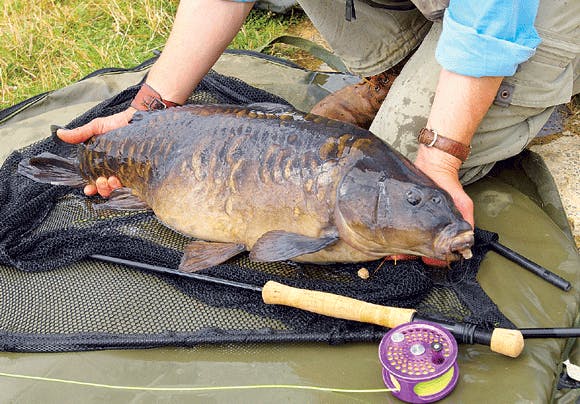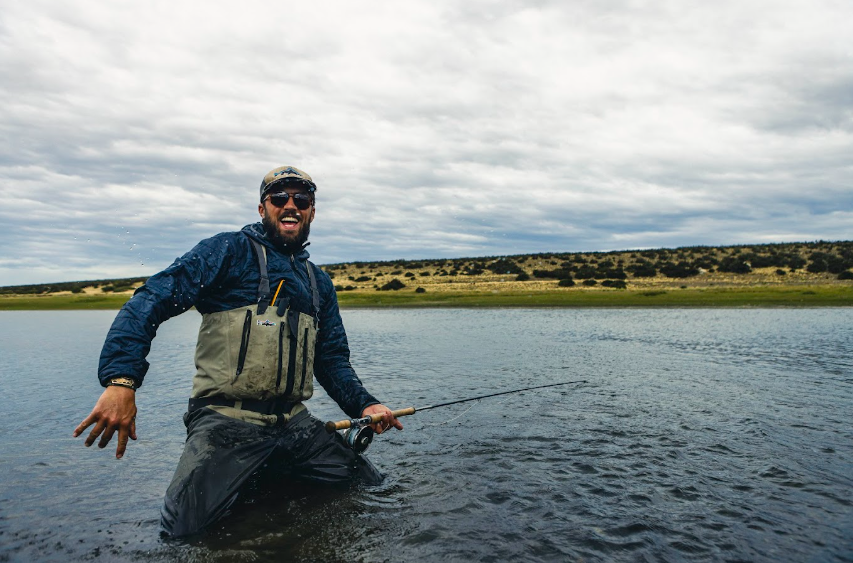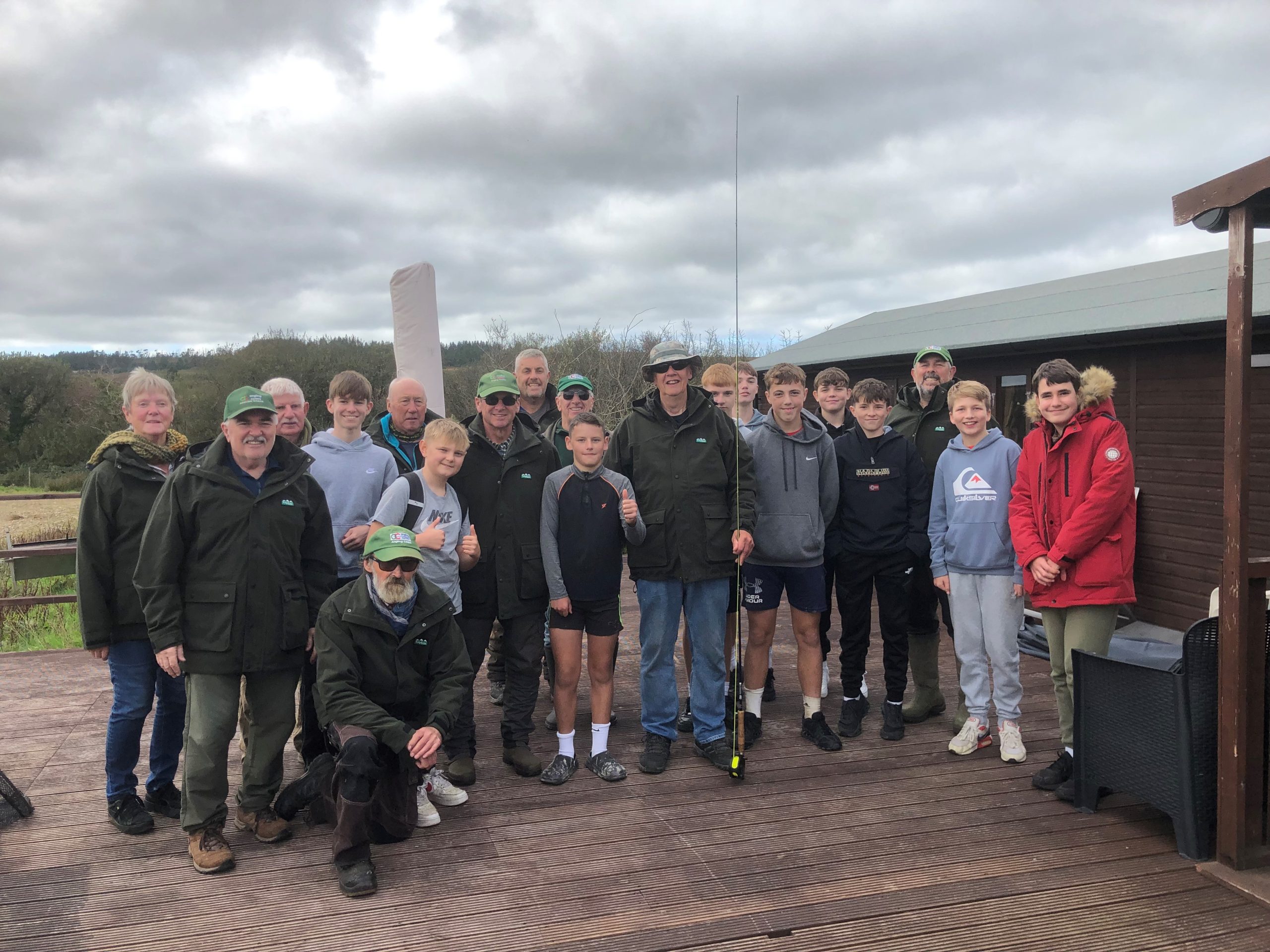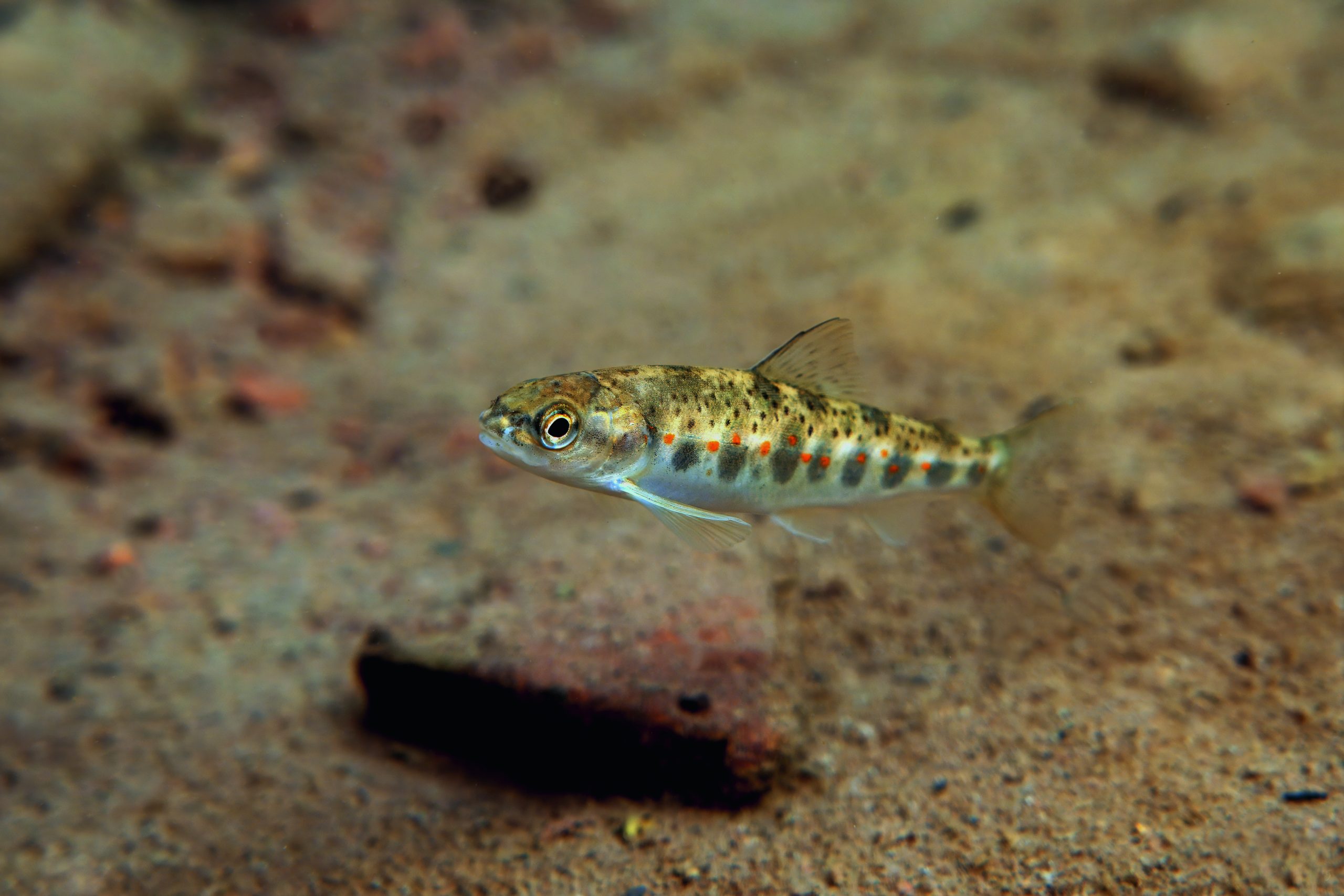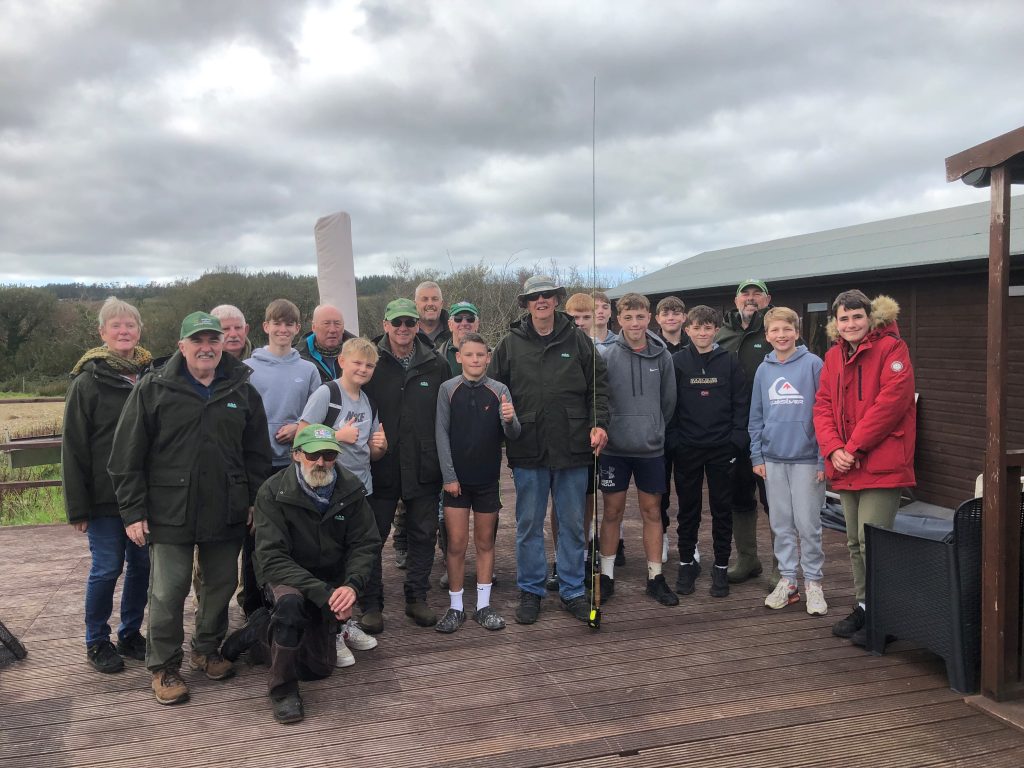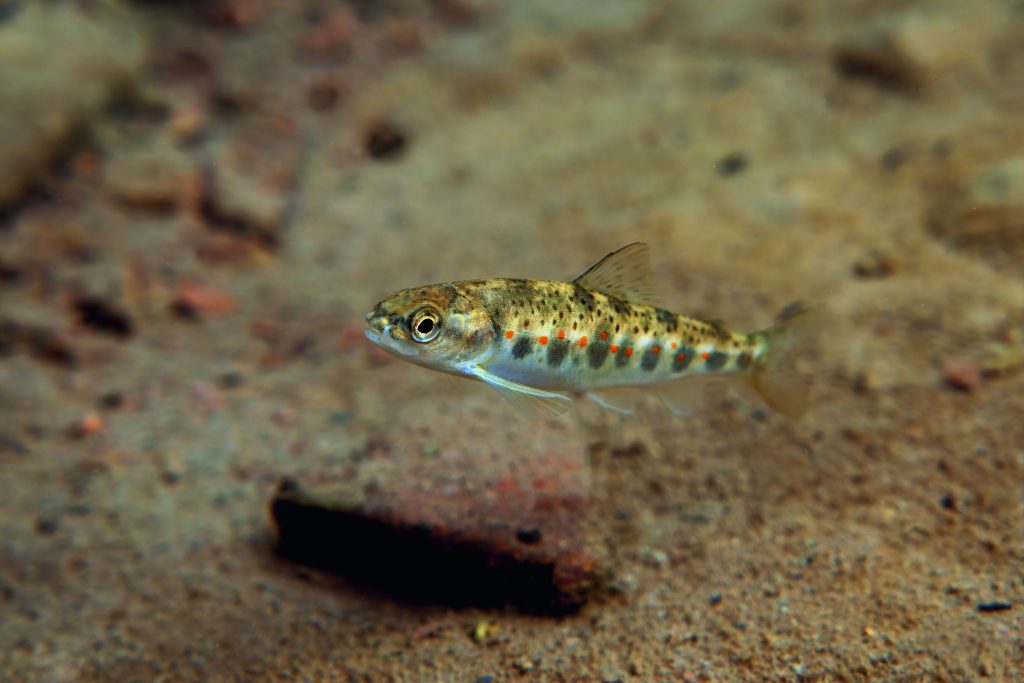TRY SOMETHING DIFFERENT – GO FLY FISHING FOR CARP
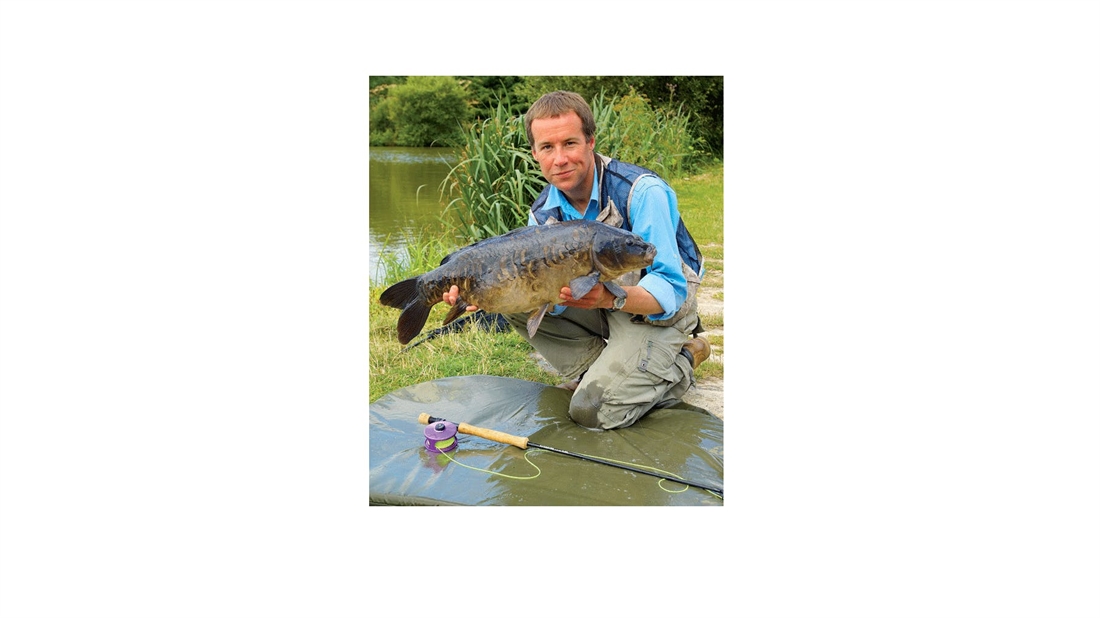
Have you ever thought of trying to catch carp using fly fishing tackle? If youve already got the gear, why not give it a try? One such angler who knows just how thrilling catching carp on flies can be is Andy Parker. Here he explains all during a summers session at Frant Fishery…
The breeze settles, revealing a scattering of semi-sunken dog biscuits on the water’s surface. I’m waiting in anticipation for the large-mouthed leviathans to systematically mop them up. And I don’t have to wait long…
One swirl…another…and each offering disappears down a watery vortex with the sound of a greedy slurp. By now the surface is alive with feeding carp.
I monitor the rise forms to decide my target. Which one’s biggest? The breeze picks up so casting is delayed; accuracy is vital to success. A few seconds later, the wind dies down and opportunity presents itself. A carp swirls, out goes the fly right on its nose. With heart thumping I wait for the huge fish to turn on my buoyant deer hair pattern. Sure enough, a large mouth sucks down the offering and I feel a mix of excitement and trepidation, simply because of the sheer size of its mouth! It kites off on a long run, pulling fly line off the reel, which, along with the rod, cries in pain. The reel’s ratchet clatters away as backing rips off in the direction of the battling carp. This is fast and furious stuff – exhilarating indeed.
The anticipation of a take is feverish but when the rod bends double due to 20lb of hard-fighting English common carp, the fight is absolutely unbelievable.
You simply MUST taste this incredible sport that potentially lies on your doorstep.
With summer here, and trout fishing perhaps limited to early and late in the day, some fly fishermen may be considering adding a new dimension to their sport. To me, common and mirror carp represent a worthy alternative to trout during these hot summer months. Why? Well, they have high tolerance and an ability to thrive in poorer oxygenated water, they come in varied and beautiful strains, they fight hard and grown big. But the biggest bonus of all is that they respond mainly to dry fly fishing.
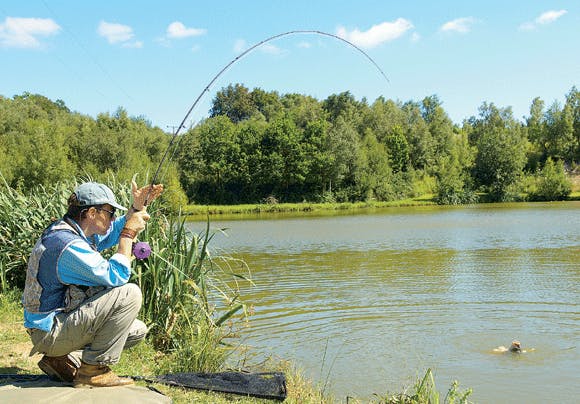
Andy has another plump carp almost beat
Sound good? Believe me, it certainly is. However, before considering your first attempt and set off in search of gold at your local coarse fisheries, careful planning and preparation is necessary.
First and foremost is carp welfare. True carp anglers treat their quarry with absolute care and respect. Anyone seen not practising the correct code of conduct will not make themselves very popular.
A few extra items of kit need to be acquired, which probably won’t be in the possession of a trout-only angler. Unhooking mats are used as a rule at all carp fisheries. Please don’t be tempted by the smallest you can find on the grounds of mobility, they can be no bigger than a deflated whoopee cushion, offering little protection to a lively specimen. I’d thoroughly recommend a design such as the Terry Hearn Euro mat made by JRC. This product is of a sensible size, offers excellent protection and also doubles up as a weighing sling.
Another plus, the sling – designed with carrying handles – makes for a swift and safe release.
Landing nets are vital, but where carp are concerned, I would dispense with trout designs – even the larger salmon gye nets – their relatively short metal handles would be prone to buckling and, of course, sinking. The actual nets themselves are generally too short across the bottom of the bag. Specialist carp nets, available through coarse fishing shops, are the best choice. With a strong lightweight one-piece 6ft handle constructed from carbon or glass fibre,
I would recommend a model with 36-inch arms which independently detach from the net’s spreader block. This would allow you to collapse the net in the margins and safely transfer a specimen to your unhooking mat with minimal fuss.
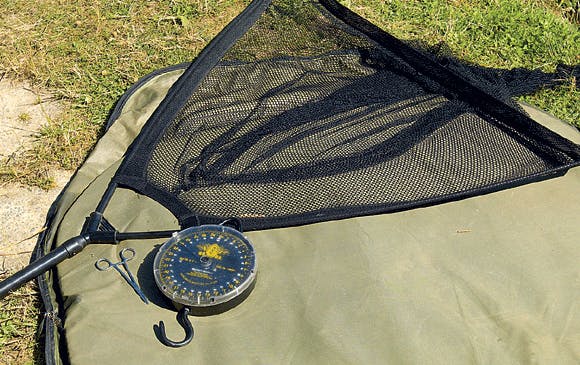
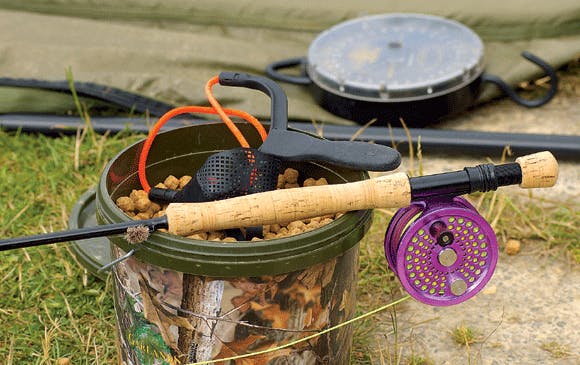
Tools for the trade: A large padded unhooking mat,
large specimen landing net, scales…
… a catapult, bait bucket and plenty of dry dog biscuits.
Pedigree Chum Mixers are a firm favourite
I regard catapults as an essential piece of a carp fly fisher’s kit. Select a model with a soft conical, particle type pouch. Opt for those with a fairly powerful elastic, but replace at least once every summer as it does degrade over time, affecting performance.
Bait buckets are necessary for transporting your floating surface feed, the five-litre size is ample. A little tip here – buy two the same size and jam one inside the other, a spare bucket will later serve for pre-wetting the mat and the carp, in the interests of its wellbeing.
I have to admit, my ‘posey’ SAS camouflage buckets appear something of a contradiction when next to one of my colourful reels!
Throw in a pair of forceps and debarbing pliers, not forgetting your floating dog mixer biscuits. That about completes the ‘must have’ kit list.
Don’t be deterred from attempting this branch of our sport because of the expense of acquiring these extra items of equipment. Their collective cost is actually little more than the purchase of two top-end fly lines!
Remember, carp will quickly exploit any weakness in your kit and certainly justify the qualities of a reel with a good disc drag, so if you have one, use it.
The age old quote “a reel is merely a reservoir for the line” doesn’t apply. If you’re not familiar with their fighting ability, a good 8-weight rod will probably satisfy most situations. But I often use a 9-weight, especially where snags and big fish are concerned. The fight itself will leave you impressed and it’s not hard to see why the species inspires a cult following amongst coarse anglers.
Possibly the highest hurdle facing a fly fisher’s first attempt is where to fish. Commercial coarse fisheries have proliferated through southern England in the last two decades, these generally represent the best type of venue to intensify your early efforts. These can be sourced by various means such as coarse fishing magazines and local tackle shops.
It would be naïve to assume one carp fishery is no different from another, which is why I’m a great believer in good, old-fashioned footwork when casing a new fishery rather than merely relying on word of mouth information. Get out there and check it out first.
Create a feel for the venue without fishing. Remember these fisheries are unlikely to be set up with fly fishers in mind. Is flyfishing actually permitted?
Some fisheries won’t allow you while others make no objections. Always check first and explain your intentions to the fishery staff.
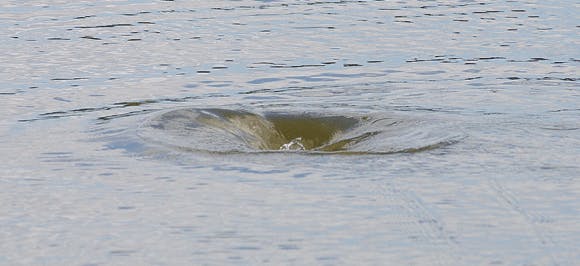
The take from a surface-feeding carp can be a gentle pluck or a savage lunge
You may also find that on some waters, flyfishing is only allowed under certain conditions, such as when the fishery is quiet, so always check first.
Secondly, does the bankside vegetation make flyfishing possible? Some waters may well have manicured banks, while some attain the natural look. Proficient roll casters will prosper here.
Do the carp regularly occupy the upper layers and succumb to surface baits? On some waters they rarely respond to offerings from above. Some well-known gravel pits close to my home, famous for their big carp and the olive flanked tench, are notorious for their lack of surface activity, a common scenario where a relatively small head of fish and an abundance of natural food is concerned. Although I wouldn’t rule out success on such hard waters, opportunities would be few and far between.
However, on the more prolific waters you may well enjoy a window of opportunity from mid April to late September, but it can vary from fishery to fishery and because of the variable nature of our seasons. On some waters, little is caught off the top until late May, with activity ending around early September. On the other side of the coin, my good friend Peter Cockwill has enjoyed superb results from Willinghurst in Surrey right into November last year, with a catch ratio which almost invariably betters the regulars. That must be a bitter pill to swallow, especially if some guy has just spent 36 hours at a venue and carried enough kit for a Himalayan exploration, only to be shown the way by someone with a fly rod and a couple of hours at his disposal – but that’s Pete for you!
On the whole it’s those long sultry summer days of June, July and August that I relish. Never be too complacent regarding safety, remember, it’s a coarse fishery and other anglers who pass behind you won’t necessarily be familiar with the mechanics of fly casting, and certainly won’t appreciate being stung by a needle sharp projectile, so take care.
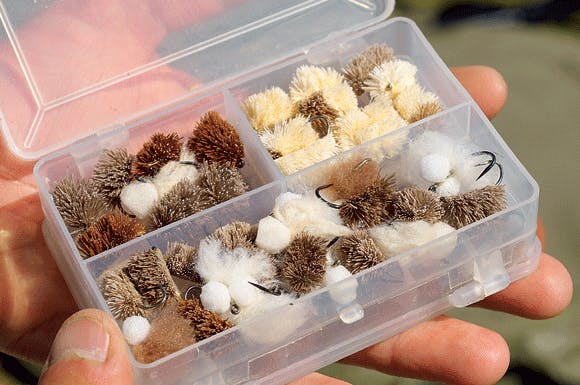
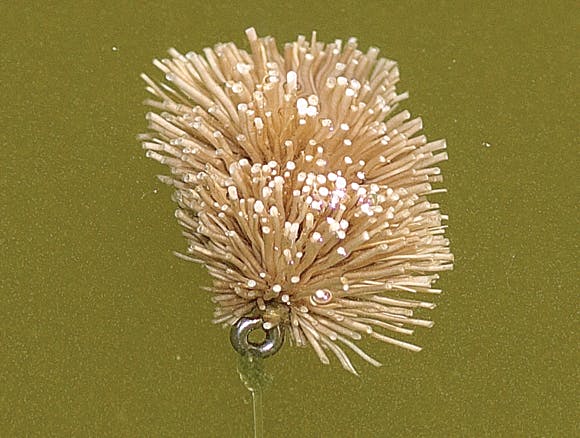
Andy prefers to use Hedgehogs of varying
colours and shades – a deer hair pattern
They are a very close imitation of a
Chum Mixer dog biscuit
I fail to remember the presence of ducks even being a problem when in pursuit of trout, but all that changes when you throw in the audible “thwack” of a catapult firing dog biscuits into the equation. As far as they’re concerned, dinner is being served! So be observant, and feed the swim carefully, preferably not when ducks are close by.
So summing things up, with suitable fishery selection and planning, you may well enjoy some superb sport. To me, carp on a fly are more than a mere cavalier flight of fancy, but an effective and very deadly tactic. I confidently predict a growing number of disciples to this method, with much interest coming from coarse anglers who, hopefully, after witnessing the delights of flyfishing, will also help support our trout fisheries.
These pictures were taken at Frant Fishery in Kent which allows fly anglers access when it’s quiet. The session began at 10.30am with quite a breeze which would hamper accurate casts. I began by firing out six dog biscuits and waited for the carp to surface. You have to get the fish up, although I’ve sometimes done okay without this. Don’t overfeed though.
Rudd showed interest first and I’ve even taken roach/bream hybrids up to 1lb on fly before the carp have moved in. But move in they did.
I took several carp to almost 19lb, with a 21-pounder coming the previous day, not bad sport on fly tackle and for a modest cost of a day ticket. You must experience their sheer power. But I had to beware of a few snags in the form of sunken trees and fences, which were actually bigger than they looked.
I played the 18lb 14oz mirror for 20 minutes, which made my arm ache. It was an old, dark specimen. Then I spent 10 minutes on a 17lb common. I also caught another common around 8lb.
TOP TIPS FOR CARP ON THE FLY
? Don’t use fly tactics close to extremely snaggy swims – huge weed beds and cabbages close to the bank. It’s not wise when using light tackle.
? Deer or elk hair flies, Hedgehogs in my case, should be trimmed ‘keel-shaped’ so they sit in the film. You’re trying to imitate a dog biscuit that has absorbed some water and settled in the film. Select the thickest fibres, not too fine. Thicker fibres flare out better when spun. You want the fly to sit 1/3 above and 2/3 below the water’s surface.
? Cast out and leave the fly static, don’t twitch it across the top as this actually scares the carp. Cast as accurately as you can – on top of the fish. In coloured water carp may not see the fly, so accuracy is crucial. A “cruiser” is the best scenario as it’s easier to predict its path.
? Takes are often quite gentle – I’ve never experienced smashed takes – and problems only tend to occur when you hit snags. Play hard, angle the rod low and high, changing angles to keep the fish guessing.
